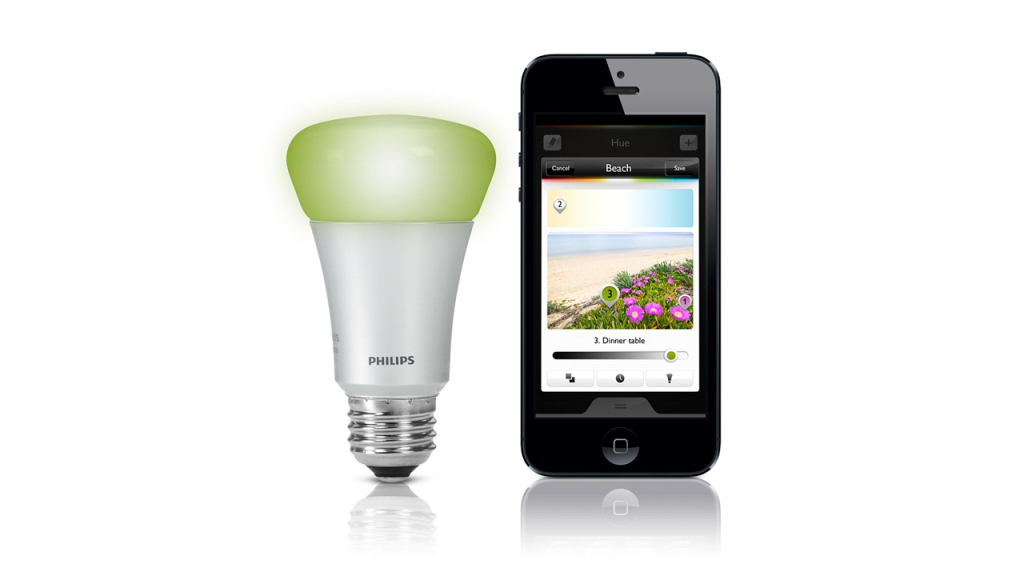The Philips Hue system feels like a gimmicky piece of hardware tie-in to the iPhone, and at a $200 starter price point (one base station and three bulbs) it was difficult to justify a purchase. Paying $60 for a lightbulb (the individual price) felt insane and the height of frivolous spending. Every part of the marketing sounded ridiculous… a WiFi connected lightbulb? That changes color? Why? Certainly it’s hyped aggressively at the Apple Store… but what isn’t? The Apple Store employees don’t have a product they sell that they don’t like.
Turns out this product is amazing. You need it.
By way of description, Philips Hue is a WiFi connected LED bulb system that can screw into any standard outlet or lamp, and offers the ability to project light in thousands of colors. There is a base station that controls a private network of your bulbs, all of which are controllable from an iPhone or Android Smartphone app. Philips says each 600 lumen bulb uses 80% of the power than older versions, and is rated for 15,000 hours of continuous use. Up to fifty can be paired with a single base station, according to Philips’ official count, though unofficially the system will apparently support more. You can also use other company’s bulbs with the system, as long as they have the same mesh networking capabilities. Perhaps best of all, Philips has an open API for developers to extend and enhance the capabilities of the bulbs, meaning developers have been writing all kinds of apps that can tie the lighting effects into anything they can dream of.
After finally breaking down and purchasing the starter pack I felt foolish even as I screwed in the bulbs and plugged in the WiFi hub that controlled the lighting. It was only when I downloaded the Hue app that I began to suspect that this might live up to the hype. First, I was surprised to see all of the third party apps that were available. I knew that Philips had opened up an API for others to develop with, but I was surprised to see so much adoption. Second, I began to realize that far from simply turning on and off lights using your phone, the capabilities were pretty endless in connecting your lighting to alarms, notifications, Facebook and Instagram, music, movies or anything else you might be doing.
Hue was easy to install, although immediately required an update that had to be performed on the PC/Mac, then on the mobile app. This was slightly frustrating and required a couple reboots of the hub device, but once completed I began to experiment with the Hue system. It was at this point that I realized I loved this product more than any other I’ve bought over the last year.
The lighting quality is extremely good, and the WiFi connectivity is very responsive. Changing colors or scenes is near instantaneous, and the color combinations are stunning. You can use your Smartphone’s GPS for geofencing, so you can program the system to flip on lights as you approach your home, or turn everything off after you walk out the door. An alarm tool can wake you at a specific time, while the timer function will shift, blink or adjust the lights when the clock hits zero.
But what’s really special is that unlike other hardware makers, Philips seems to have no interest in hoarding the technology and hardware to themselves. With an open API and smart partnerships, Philips has built an ecosystem that continually evolves and expands Hue’s capabilities. One of the most valuable is a partnership with IFTTT (also known as “If This, Then That”), which lets you create quick combinations called “recipes” for an unlimited number of functions. The process doesn’t require a developer; it’s as drag and drop as it gets, all built to use a web tool or your mobile phone. As an example, you can have your lights automatically glow in a color that reflects the weather forecast for the next day before you go to sleep, or flash if you have a new post to your Facebook, LinkedIn, Evernote or Twitter account. Your lights can blink a color if you get email from a specific sender, or be set to cycle based on a song or movie soundtrack.
Say you’re watching Blade Runner; you can set your lights to respond to the movie by projecting ambient lighting in your room that’s tuned to the movie you’re watching. Is there rain? The lights can flicker blue. Sunset? Reds and oranges. The potential is endless. If you’re listening to Last FM, Pandora or Spotify you can have the lights automatically cycle and shift based on the music you’re listening to. The experience is far more immersive than anything 3D TVs can offer.
Philips Hue is the kind of product you think is going to be silly and winds up changing the way you think about lighting and its effect on your life. While the starter price is a hill to get over, it’s worth the investment and you will find yourself finding all kinds of ways to take advantage of everything it has to offer. Easily the best Mobile connected product I’ve come in contact with. Highly recommended.
